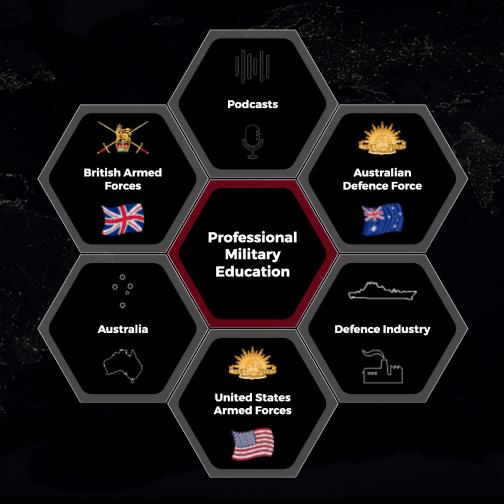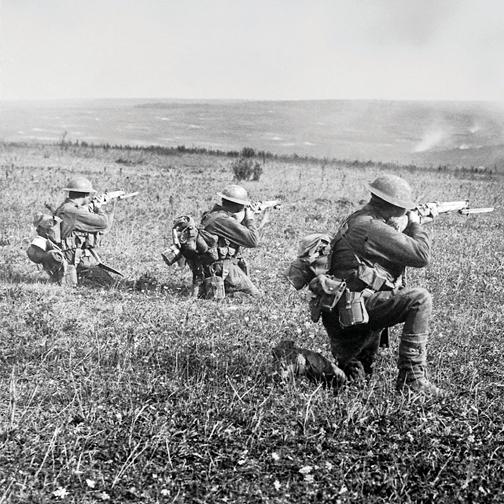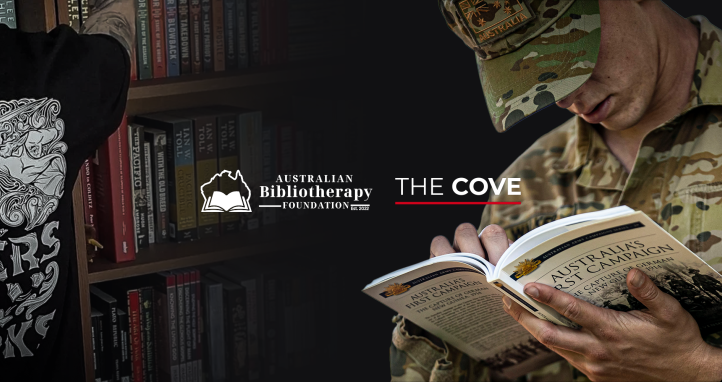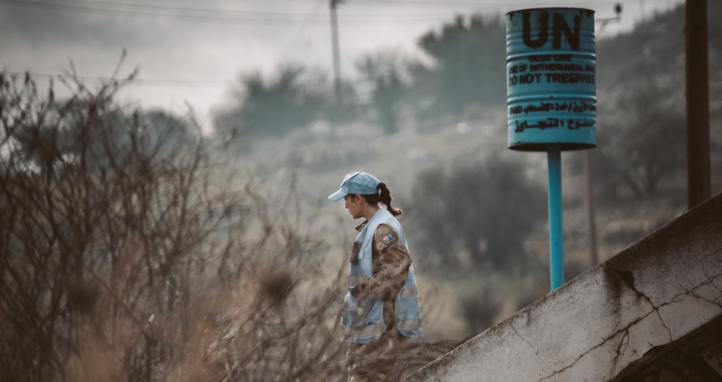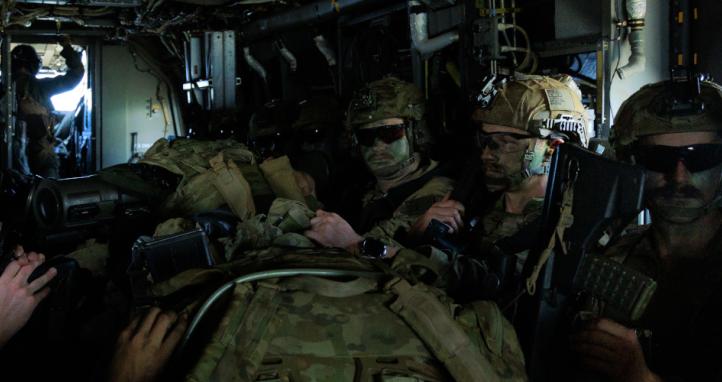As the First World War made painfully clear, when politicians and generals lead nations into war, they almost invariably assume swift victory, and have a remarkably enduring tendency not to foresee problems that, in hindsight, seem obvious.
– Adam Hochschild[i]
INTRODUCTION
Since Operation Bushfire Assist 19-20, the Australian Army’s part-time force-in-being has increasingly been relied upon to conduct domestic operations in support of Australia’s national interest.
With the release of the National Defence Strategy, the 2nd (Australian) Division (2 Div) has been tasked to generate a permanent homeland defence command structure through Joint Task Force 629 (JTF 629) and generate multi-purpose forces in support.
To an observer, this appears to be a logical mission expansion, based upon past success. However, upon closer analysis, it requires a fundamental rethink about how 2 Div generates the force for employment by JTF 629, to fight tonight.
PROBLEM SCOPE
During its response to floods, bushfires, and a pandemic; JTF 629 required the assignment of general-purpose forces with minimal training liability who could round out and reinforce as groups of individuals without collective certification. These individuals came from within 2 Div and from across all services of the ADF.
Government direction now requires homeland defence forces to be prepared to face a greater threat, requiring significant individual skills and periods of collective training before operational employment. If utilised in this circumstance, concurrency pressures will exist across the ADF, with JTF 629 relying heavily upon mass generated from units within 2 Div as it undertakes its Raise, Train, Sustain role.
With this reality, and an unknowable timeline, 2 Div must focus its force generation to maximise its total trained force, to create the base for force expansion and/or protracted operations.
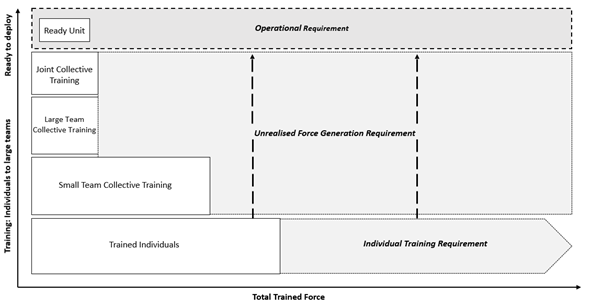
Figure 1: Operational generation requirement concept
Figure 1 depicts the current process of generating a task-organised force element from a variety of 2 Div units to be force assigned to JTF 629. It demonstrates the importance of sequencing the generation of mass through individual training, to produce trained individuals who progress into trained teams, through collective training, and ultimately deploying as a force element. Whilst not depicted, time is a critical resource, with the generation process needing to deliver the ‘ready’ force at a designated point in time.[ii]
APPLICATION TO THE 2nd DIVISION
Presently, 2 Div is realising directed operational requirements through utilisation of the force-in-being, with additional training to meet individual requirements and joint collective training capstone activities, prior to potential force assignment. The 2nd Division does not currently conduct a complete and sequenced force generation cycle to deliver a follow-on force at a directed point in time.
This denies the opportunity to train for the generation of subsequent forces, should they be required. It also transfers risk from the training environment to the operational environment, for want of organisational memory. Presently, it is a system that can only generate the force once and is at risk of perpetually retraining itself for marginal gains.
An alternate approach for 2 Div is the deliberate generation of forces over time to replicate the requirement for protracted operations, including round-out, reinforcement, and rotation. Successful implementation will provide an appropriately structured and rehearsed organisation to achieve force growth, on demand.
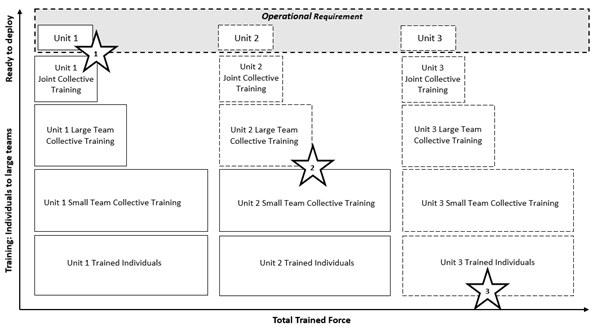
Figure 2: Generating a force in time
Figure 2 depicts a proposed force generation model to realise a trained and prepared force for a point in time, including follow-on forces. Simplistically, it provides a cascading model, where at a decision point (depicted by numbered stars), the next task-organised force element 2 Div commences preparation from its extant level of training and readiness, to progress up the preparedness chain, ultimately being force assigned and utilised as a follow-on force.
Using this deliberate approach enables focus and prioritisation of resources to deliver an assured force to a force employer, namely the commander of JTF 629. It orchestrates the individual training system to enable the generation of an infantry soldier over several months, and the recovery mechanic over months to years; however, both will march into unit’s collective training together. Further, the model solves for leadership and specialisation depth, allowing for preceding force element soldiers and officers bring their experience to raising tertiary force elements, including being available to raise ‘twinned’ units in the event of expansion.[iii]
RECOMMENDATIONS
From a training perspective, implementation will require a reorientation of effort within 2 Div, moving from training design and exercise planning to workforce planning and assurance/certification activities. The implementation will require initial investment in understanding the workforce and its training requirements, measured by time.
This will include primary, secondary and tertiary mapping of staffing documents to understand the force-in-being and the individual training requirements to generate all required trades, at all ranks. Through this process, workforce insights will identify gaps in key trades, and the realisation that primary through to tertiary individuals filling staffing documents may need to commence training together to create throughput across time and to create force depth.
The role of collective training will be adapted with a focus on command and control integration between Joint Operations Command and JTF 629, and from JTF 629 to subordinate Joint Task Groups. This alternate focus will empower units to concentrate on developing their teams (up to sub-unit size) in their specific trade or role to a directed level of preparedness, pending task organisation prior to force assignment.
CONCLUSION
By generating force elements using a deliberate approach, and applying focus, prioritisation and sequencing, the 2nd (Australian) Division will be postured to meet current operational requirements, as well as be conditioned to scale highly capable force elements for foundation warfighting under the command of JTF 629.
End Notes
[i] A Hochschild, To End All Wars: A Story of Loyalty and Rebellion, 1914-1918, Houghton Mifflin Harcourt, New York, 2011.
[ii] See C Field, ‘Fighting by Minutes: Time and the Art of War’ by Robert Leonhard, The Cove, viewed 16 April 2025, <https://cove.army.gov.au/article/fighting-minutes-time-and-art-war-robert-leonhard>.
[iii] See S Gabriel, Re-raising the Seventh Battalion, the Royal Australian Regiment, Australian Army Journal, Vol. 20 No. 3, viewed 14 April 2025, <https://researchcentre.army.gov.au/library/australian-army-journal-aaj/…;.
